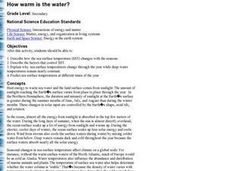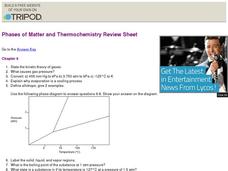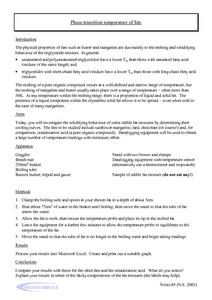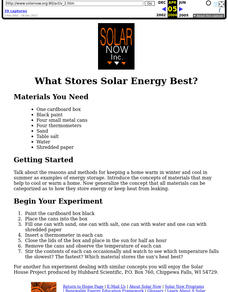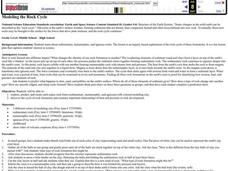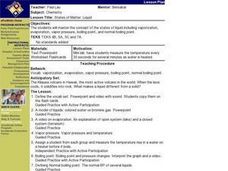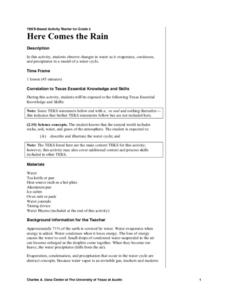Curated OER
Hydrologic Cycle
In this science worksheet, students examine the hydrological cycle through the coloring of the picture that graphically organizes the concept.
Curated OER
A Content Lesson Througha Communicative Sequence
Students see pictures, and are asked to respond to them. The teacher focuses on pointing out new vocabulary that may be embedded in the picture. They relate another person's journey to themelves.
Curated OER
Heating a House in German
Students reinforce and expand their knowledge of other disciplines through the target language.
Curated OER
How Warm is the Water?
Pupils research how surface sea temperature changes throughout the year. They draw a time series of sea surface temperatures for each month of the year and a depth profile for a summer and winter month using an OceanExplorer Profiler tool.
Curated OER
Demonstration of Factors Affecting Soil Temperature
Learners examine the influences of water and mulch on soil temperature. For this investigative activity students complete a soil experiment.
Curated OER
Atmospheric Processes -- Convection
Students work together to discover how temperature changes can affect the density of water and air. They make predictions on what they believe is going to occur. They answer questions to complete the activity.
Curated OER
Phases of Matter and Thermochemistry
In this theromochemistry worksheet, students review the kinetic theory of gases and the three phases of a substance. Students calculate how much heat is required to raise a certain mass of solution a certain number of degrees. This...
Curated OER
Transfer of Thermal Energy
In this thermal energy worksheet, learners will explore different ways heat is transferred including conduction and convection. Students will look at how insulators work and how room temperature can affect heat transfer. This worksheet...
Curated OER
Processes of the Rock Cycle
Students explore, predict, and create each major rock form (sedimentary, metamorphic, and igneous) with colored modeling clay, discover cycle of rock formation, and examine important relationships of heat and pressure in rock development.
Curated OER
Solids, Liquids, and Gases
First graders explore the properties of matter. In this states of matter lesson, 1st graders conduct scientific investigations that require them to mix, cool, and heat objects in order to observe changes in the properties of matter.
Curated OER
Phase Transition Temperature of Fats
In this chemistry worksheet, students investigate through experimentation the solidifying behavior of some edible fat mixtures by determining their cooling curves. Then they data-log equipment to obtain a large number of temperature...
Curated OER
Phases
In this phases worksheet, learners rank the chemical compounds by decreasing vapor pressure. Students use a phase diagram to determine if water undergoes any phase transitions during the four steps described. This worksheet has 8...
Curated OER
Some Like It Hot, Some Like It Cold
Learners are explained that thermophiles are organisms that have optimal growth temperatures above 50oC. They investigate the temperature ranges for the growth of common bacteria. Students answer the question of do either of these...
Curated OER
Tsunamis
Learners investigate the natural disasters known as tsunamis by researching the Internet. In this nature lesson, students define the word tsunami and discuss how they are created. Learners complete an online activity based on water...
Curated OER
Changing State
Students investigate the cooling and heating of water. In this online science experiment lesson, students work in groups to make predictions regarding freezing and boiling points and then test those predictions as they complete the...
Curated OER
Keeping Warm
Fifth graders measure the temperature of water using a thermometer. They record the temperatures of water on a chart. Students use the temperature data to determine which materials are the best conductors of heat. They discuss their...
Curated OER
The Same but Different Part II
Third graders experiment with beakers of water and balloons to measure the volume of the gas in the balloon. They determine ways to change the volume of air in the balloon which changes its size but not its physical state. By heating the...
Curated OER
Don't Marry the Mole!
Third graders examine the power of solar energy. In groups, they create their own pizza box solar oven to discover the power of the sun and how it is a source for heat and light. To end the lesson, they use the internet to examine...
Curated OER
What Stores Solar Energy Best?
Students discuss reasons and methods for keeping a home warm in winter and cool in summer as examples of energy storage. Students participate in a solar energy experiment.
Curated OER
Modeling the Rock Cycle
Students explore the differences in sedimentary, metamorphic, and igneous rocks. They discuss the rock cycle of the different formations. Students discuss how rock is formed into different shapes. They explore, predict, and create each...
Curated OER
States of Matter: Liquid
Learners work in a mini lab where they measure the temperature every 30 seconds for several minutes as water is heated. They are asked what makes liquid different from a solid. Students view a PowerPoint on the model of liquids,...
Curated OER
Ground Level Ozone Testing
Students prepare Shoenbein Paper to test the ground level of ozone. They dip a strip of their test paper in distilled water and hang it at a data collection site. They determine the relative humidity of the data collection site. Using a...
Curated OER
The Learning Bottleneck
Students identify and analyze what energy is and how they feel after moving around a lot. They identify other ways that they can acquire heat and if there is some sort of mechanism for storing energy. Finally, students construct their...
Curated OER
Here Comes the Rain
Second graders help to prepare a model of the water cycle before the conduction of this experiment. They use the model in order to observe changes that happen to water when it changes states of matter.





